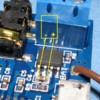That module can indeed reduce wiring. BTW, posts with direct eBay links can be deleted/modified by OGR moderator per terms of use. I post the image of the listing which should be enough info to find it; other guys post the eBay listing number though that goes stale after a few months. In any event, $1.31 with free-shipping from Asia.
Here are some observations which may or may not be relevant in the context of a crossing-gate application.
1. The speaker will pop on initial application of power. I'm fairly confident that you can add a capacitor to demote this effect.
The module has an un-marked audio chip. I have an idea of what it is - or at least enough to suggest the capacitor modification as shown (across C6). The separate audio amp module (available with or without volume control knob) uses the PAM8403 IC audio amp which is well documented in terms of providing detailed info on how a capacitor affects the pop, noise, etc.
2. The module has a mono audio-amp. So somewhere on the board the Left and Right channels of the stereo MP3 sound are combined. The separate PAM8403 audio-amp module has a stereo amplifier - 2 audio inputs, 2 amplified audio outputs. As discussed earlier, if you have two locations where you want layout sounds, they can be completely independent. Or if you can dream up an application to take advantage of the stereo to create some fun effects - like a train passing left-to-right and/or right-to-left with Doppler effect proportional to speed, or plane flying overhead, etc. This would require a stereo or 2 independent audio amplifiers (and 2 speakers).
3. If using a separate audio-amp, there are PAM8403 versions with a manual rotary-knob volume control. My notes show this module will always start up at max volume. I believe you will be driving your setup with an Arduino. So I suppose you could use the Arduino to adjust the volume by using some digital outputs to emulate the push-button Volume+ and Volume- buttons. Note that these highly integrated widgets tend to multi-plex the switch connections with other functions so it's not just a matter of writing a HIGH or LOW to a pin connected to a switch to effect CLOSE or OPEN. I didn't consider the Arduino button interface but it might require using an OC/OD (Open Collector, Open Drain) output pin or even adding an electronic equivalent of a relay (i.e., an analog-switch chip).
4. I did not study this module enough to confirm if you can directly apply 5V DC as the power source. Presumably the BAT+ and BAT- connections are for a standard 3.7V Lithium rechargeable which seems to be the assumed power source for these tiny MP3 players. OTOH, as this module has screw-terminal connector for the speaker, it was clearly intended for DIY applications. Also, I did not check to see if some kind of charging capability is built-in.
5. I noticed this module has a longer start-up time (from application of power to sound coming out). I don't have any numbers written down but it was noticeable enough that I remember it. In general I've noticed for these MP3 players that the larger the memory card, the larger the start-up time. Additionally, the time it takes after finishing one .mp3 sound and starting the next one (or repeating a single .MP3) seems proportional to the size of the memory card. I've not studied this in any depth as I typically use a 64MB or 128MB cards with one .MP3 file on it.
Again, many/most of these comments may not apply to your crossing-gate application...








